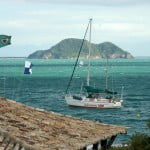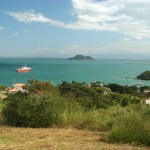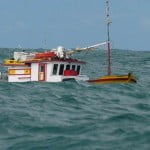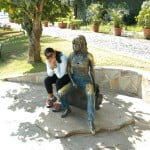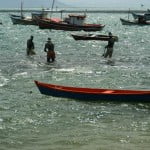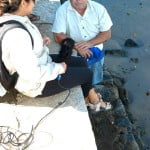Thursday, 11 – 05 – 2006.
Hurray! One more trip is about to begin. I don’t know how I will feel when this project ends. I’ve rarely worked with something I enjoyed so much. And I loved my work at Eldorado Radio Station. In addition to having pleasure, getting the knack, the language and the rhythm of TV work, I’ve learned tremendously about the sea and its issues by interviewing specialists, reading specific literature on subjects which come up as we go down the Brazilian coast. I’ve visited amazing places and I’m sure more beautiful places are waiting for us. Every month I’m in my sailboat where I feel better than at home. What else could I long for? Well, we took a plane in São Paulo and flew to Rio de Janeiro. We landed at Santos Dumont airport at 9 a.m. I rented a car and Paulina, Cardozo and I went to the campus of Rio de Janeiro’s Federal University for the two first interviews we had scheduled. I wanted to know more about a phenomenon called “resurgence” in Cabo Frio which is one of our stops during this trip.
We talked to Professor Jean Louis Valentin from the Institute of Biology of RJ’s Federal University. He has been working on this subject and area since 1972. Then we spoke to geologist Edson Farias Mello who told us about ore beds in the oceans. We also scheduled new interviews with professors from the Geology Department who are experts on oil extraction seeing that we are going to sail in Campos Bay. We finished about midday and then went to Buzios where we arrived in the middle of the afternoon. As usual, Alonso was waiting for us at the Yacht Club. The Endless Sea was beautiful, attached to one of the buoys of this charming club at Ossos Beach. We will explore the neighborhood tomorrow. Today, we’ve hardly had time to unpack and then we left the boat again to have “lunch” (it was 7 p.m.) and went back on board to go bed.
Friday, 12 – 05 – 2006.
We were told in the morning that a new cold front was coming up the Brazilian coast and it will probably be here tomorrow. We hurried up to shoot the beautiful beaches showered by the blue sky. From now on we will be constantly fighting against cold fronts. This thing didn’t worry me when we were in the North and Northeast. They rarely arrive in those regions; however, in the Southeast, especially during this period of the year (Fall and Winter), you have to be prepared for them. If they are simply weak, they may affect the color and the beauty of the programs since shooting images of the coast with clean sky is always more beautiful. Nevertheless, if the fronts are strong, they may bring not only discomfort but also more serious problems which can jeopardize the integrity of the boat and that of the crew.
In fall and winter there are no hot air masses over Brazil which block or make it difficult the penetration of cold fronts. It is different now. When the temperature is colder there is no barrier for these fronts which come up from the Antarctic. One after another sometimes in an endless series. As soon as I arrived on board, Alonso confirmed that since he arrived here the Southwest wind has constantly blown. The intensity of the wind simply decreases or increases; it always comes from the south bringing black clouds, cold, rain and making the sea stronger against us.
Buzios is a very beautiful swimming area in the state of Rio de Janeiro which became famous at a local and international level when Brigitte Bardot visited it in the sixties and was charmed by its beauty. It has been a trendy place since then. Today, it attracts crowds. It is bigger than its infrastructure; this is the first problem we’ve seen. Just to give you an idea, according to IBGE’s data (2000) there are 18.200 inhabitants who live in 5.340 private homes. Only 212, that is 0.04% have sew systems! As usual, human waste goes straight to the sea.
Now imagine Buzios on holidays and vacations when hundreds of hotels, pousadas and condominiums are full of tourists. Do I have to say what happens?
Walking around here I could also see that the green cover decreases and cement has more room. There are no buildings, fortunately this is forbidden by the director plan which deserves our compliments. On the other hand, there are houses on the slopes and at the top of almost every hill. In spite of that, the beauty of the beaches and creeks resists. The color of the water is special as well; it ranges from green to dark blue. The center of the city is very charming, with fashionable stores, narrow streets covered with stones; restaurants and bars offering a wide range of prices and tastes. And there are also people who still make their living from fishing, not too many, probably due to the so-called “resurgence” which occurs in this area.
At about three p.m. the Southwest wind was stronger. The blue sky was replaced by light gray. A few minutes later it was even darker. The sky was completely black and then it rained and it was cold. Eddying waters almost invaded the streets. Strong waves crashed onto Armaçao beach where there is a small commercial center. The cold front seems to be stronger than forecasted. We weren’t able to interview a few old inhabitants to know what they feel about the changes in the calm village where they were born. Instead we had to go back to the comfort of the Endless Sea where we have been up to the present moment, 11.00 p.m.
We intend to sail to Macae tomorrow, 20 miles northwards. However, if it is windy, it is not worthwhile. We are sheltered here and we haven’t interviewed local inhabitants yet. It is important to know what they think about their city. There are no doubts about what tourists think: they love the lively atmosphere.
Saturday, 13 – 05 – 2006.
In spite of yesterday’s bad weather, the sky was blue at dawn. But it was cold. We left the boat to look for a few fishermen to talk to. It didn’t take us long to find them. There is a fishermen settlement near where we were and there was a group talking next to a few boats. We soon realized it was the group we were looking for. Our reporter, Paulina Chamorro, after a couple of minutes was talking to one of them like a friend. His name was Tinho, a strong man in his forties.
“Is there a lot of fishing today?,” Paulina asked. Very friendly and extrovert, Tinho spoke freely: “there are almost no fishes left; groupers and serranoids are gone. Lobsters disappeared; it is getting more difficult to live from fishing. We can hardly pay our costs.” “What about tourism, does it warm up economy?” “Not at all,” he said.
We saw a few Argentineans, a couple of tourism buses, and some people from Chili walking around. However, it seems that this activity hasn’t been strong enough to yield income and generate new jobs for the local community, at least out of season like now. Tinho told us that most fishermen sold their houses at the seaside and moved to distant areas far from where they make their living. He said that they couldn’t find any other way of earning money. They still depend on the capricious sea. We spoke to them for over half an hour and then we tried to find an old inhabitant who had met Brigitte Bardot. Did he know anyone? He told us to go to a fish place not far from there.
We met Seu Manoel Lopes, near his eighties, sitting on a stool in the shop, looking at the sea while the owner of the shop was putting ice in the fishes on the counter. Yes, he saw the French actress several times and “she loved a native, Dalva, a short woman, who would take her everywhere.” Bardot was very beautiful, “with blond hair which was like the color of gold.” Seu Manoel also met Juscelino Kubitschek, who had been so often to Buzios that local people paid homage to him. In one of Buzio’s streets there is a statue of his sitting on a chair holding a hat in his hand. Manoel Lopes told us that he went shrimp fishing with JK, “a very nice and simple person.” After, he confirmed what Tinho had told us; he complained a lot about the local administration which instead of supporting Buzio’s inhabitants brings buses from other areas full of workers for jobs generated by tourism. “It is not fair, is it?”
Yes, Seu Manoel, you’re right. We have seen this situation in almost all the states of the Northeast.
We ended our visit in Buzios with this interview. Before leaving we had to pay the Endless Sea’s stay at Buzio’s Yacht Club and then go to Macae.
While Paulina and film maker Cardozo were going on board, I went to the Yacht Club’s office to pay. But … surprise!!! The commodore was kind. “Send me a copy of the TV program and have a nice trip.” Cool, we got rid of this bill.
I went on board right after that and we continued our trip. Before going to Macae, I took a boat to go alongside the cape of Buzios to shoot the occupation from the sea. This is the only possible way to see the damage on the scenery caused by the houses built on the slopes and at the top of the hills, the lack of vegetation due to the chaotic occupation, or the monotonous condominiums with unattractive and boring houses, one like the other, it seems a huge eucalyptus plantation …
And then we put 030 degrees on the compass, we lifted the mizzen sail, opened the genoa (prow’s big sail) and sailed marvelously pushed by the Southwest, went smoothly through the waves at more than eight knots. We arrived in Macae at the end of the day. Alonso had a lot of fun at the rudder facing the strength of the waves. Cardoso was sleeping in the sitting room and Paulina in the cabin. I was in need of a nice sailing and read a little bit in the cockpit, took pictures of the crew and made lunch. I wanted everything ready as soon as we dropped anchor in Macae. And it worked out well. As soon as the anchor touched the bottom of the sea, I served roasted beef with rice and au gratin potatoes. Good red wine was served too. It was really good. We ate and went to bed. Tomorrow we have a lot of work. We will go by car to the mouth of Paraiba do Sul, it is about 100 kilometers northwards, near Espirito Santo’s border.
Sunday, 14 – 05 – 2006.
We left very early in the morning. On our way we stopped in the district of Farol de São Tome, at the cape which has the same name, a remarkable place of the Brazilian coast. It is exactly here that the contour of Brazil’s coast line changes. From Rio Grande do Norte to this point, it goes down following the north-south line, but at São Tome Cape it changes and it goes east-west.
I’ve already sailed in this area very often and I always wanted to know how the city and the beaches were. I was going to find out today.
The city itself has nothing special. It is neither ugly nor beautiful. It is simple. The lighthouse is 200 meters from the beach and it isn’t special either. The beach, at last, is huge and extremely long and the strong waves are brown. This is due to the fact that this area is relatively low and there are strong winds. The agitation of the waves revolves the bottom of the sea and this unusual color results from that. The funny thing is that the fishing boats “park” on the sea. Yes. Since there are no shelters and the fleet is big; fishermen must remove the boats with tractors and without carts. They drag the hulls along the sand. This is the only way to protect them. I imagine how hard this daily insane work is, having to drag dozens of boats, some of them are 40 or 50 feet long, with chains attached to tractors. Not to mention the cost of fishing, which increases a lot due to this additional work. I would like to stay here a couple of days to shoot all this, but as usual we are in a hurry. We were able to shoot and take pictures of all the boats on the beach, just to give an idea to those who follow us of this unusual solution. And then we continued our trip.
At three p.m. we arrived in the district of Atafona, where the mouth of Paraiba do Sul is, a wonderful place. Espirito Santo’s border is a little bit further. The source of this river is in São Paulo and it is one of Paraibuna’s affluents. It crosses the southeast of Minas Gerais and enters across Rio de Janeiro. In Rio’s metropolitan area it serves ten million people. Along its 1.150 kilometers, it receives one billion liters of domestic waste (source: SEIVAP, Paraiba do Sul’s Integration Committee) every day, due to the lack of basic sanitation in the cities along the river. There is only 11% left of its ciliary forest. This is the reason why it is obstructed. The waters don’t bring sediments and cause erosion at the beaches destroying many summer houses which had been built near the sea. Yes, that’s what happens. The thing is repeated again, we insist on not learning with past mistakes… But it is a wonderful place, I have no doubts. We returned to Macae in the evening. Tomorrow we are going to interview district secretary, Alexandre Gurgel, and we will check if the oil royalties are being well used here.
Monday, 15 – 05 – 2006.
Macae is unattractive. The beaches are not really beautiful. Anyway, natural beauty is not the reason which brought us here. We came to see how the royalties have been used. If you don’t know, Petrobras has been paying this type of tax since 1997, as a compensation measure of the oil extraction activity. As you know, the Bay of Campos, where most of the Brazilian oil is extracted by Petrobras, is in this area. In 2006, Macae will receive 350 million reais which represent approximately half of the amount collected by the district. The sum of money is controlled by ANP (National Oil Agency) which audits and figures out the amount for each region of the country.
Macae has 124 thousand inhabitants who live in 38 thousand private homes. 66.5% have waste treatment and 94% have garbage collection. It is almost a record. Up to the present moment, only Salvador has higher levels (68%) and it is the capital of the state not a district.
Just to make you understand, Natal, in the state of Rio Grande do Norte, has one million inhabitants; however, only 20% of their homes have waste treatment. São Luis, in the state of Maranhão, with one million inhabitants who live in 246,000 houses, only 37% benefit from waste treatment…
We interviewed Secretary Alexandre Gurge who explained to us that within two years, before the end of the present mayor’s power, the entire city will have waste treatment. Excellent! At least one of the districts of our coast won’t be using the sea as latrine. This single aspect made the trip worthwhile. But there is more. Petrobras’ royalties enabled every child at school age to be at school. People from Macae and the mayor are proud of the District Hospital. It is a model hospital where medicines are sent to the patients’ rooms through a pneumatic line, just to give you an example. Macae was awarded by the UN for the education system offered to its inhabitants. Macae is the third Brazilian district in terms of standard of living. All this thanks to the oil!
So, there isn’t any problem? “Of course there is”, says the secretary “there is no miracle”. In twenty years, the population doubled, especially due to migration; they all come looking for this better standing of living. However, growth was followed by crime, drugs and slums. In spite of that Macae is remarkable at a national level.
What about fishing? We have seen lots of fishing boats. “Yes”, says Alexandre Gurge, “this activity is still important; it employs approximately 15 thousand people, with a fleet of about 600 boats. We have a production of 700 tons per year and we represent 15% of Rio de Janeiro’s fishing.”
Mission fulfilled. We saw what the richness of the sea can yield for coastal cities. It is time to leave. Fortunately, today we have some free time, there is weak wind oscillating between east and south. We left the secretary’s home, where the interview took place and rushed to the port where the Endless Sea was. We were right away on board and went towards Cabo Frio, our next stop.
I rested. I went to the comfort of the stern cabin and slept deeply. I woke up a couple of hours later and the sea was swinging more strongly compared to the beginning of our sailing. I was astonished when I saw the violence of the waves and how dark the horizon was. Black heavy clouds were coming closer dangerously. A new front was coming. Fortunately, we were near Buzios were we stopped to be sheltered. We face nature’s forces in the last resort. We changed our route and half an hour later we were in the bay of Ossos beach, at the same point of the Yacht Club where we had stayed. It was seven p.m. We were told about the civil war in São Paulo carried out by PCC because one of the leaders, a criminal known as Marcola, had been transferred to a maximum safety prison. It is very sad to realize that a city like São Paulo, the biggest in Brazil, is turned into a battle field for so little. This is one more proof of the state administration failure. Our TV doesn’t broadcast anything where we are and everybody from the crew wanted to have information. We left the boat to watch the TV news.
It is unbelievable. Buses on fire, schools and colleges closed, just like in the streets of Bagda. Marcola made São Paulo kneel. Almost 100 people were killed. It is said, but already expected. This results from an anachronistic Legislation, a morose Justice, unscrupulous lawyers constantly going into and coming out of prisons without being inspected; taking and bringing messages to their clients; congressmen who don’t work and neglect bills. I hope we will be more successful in our next elections.
Tuesday, 16 – 05 – 2006.
We started our sailing to Cabo Frio at dawn. We were just 14 miles away. We will be there in less than an hour.
The noise of the motor woke me up and I went to the deck to feel the breeze and look at the landscape. There are several islands on our way. We were close enough to the coast to see the contours clearly. As we were enjoying the beauty of the scenery, I suddenly felt a shock coming from the bottom of the hull. The motor stopped right away. I froze. What was it? The motor blocked? Alonso left the rudder and checked the engine room; and I, after thinking for a while, went to the stern to see if our helix had been caught by any net. Apparently, there was nothing. I returned to the cockpit and waited for Alonso. He said there wasn’t anything abnormal in the engine room. And then I looked again at the stern frame. I kneeled on the deck and stretched my neck; I was almost touching the water. I was able to see. We had caught a thick cable, as thick as my arm or even bigger. For God’s sake! I will have to dive. Poor me! Cabo Frio (Cold Cape) is called like this because of the cold waters which result from the famous “resurgence”. I put my foot into the sea to have an idea of the temperature, slowly, I was afraid of the sensation. Fortunately, it was warm. Then I remembered what Professor Jean Valentin who we interviewed in Rio had said. When there is Southwest wind, the waters of the area become warm. They are cold only when the Northeast wind blows. Fortunately. I put the mask on, I dove and checked the axle. Jesus, the cable was very thick like those used by ships to anchor at the platform. I could kill the rat who left it afloat.
I dove again with a knife and down in the water I started to cut it to release the axle. But it was going to be tough and tiresome. It took me an hour and a half of diving with intervals of rest. At last, with my breast about to explode, I finished. Then I promised to myself that this is the last year I smoke. In the past I had an extraordinary breath. I could stand two minutes without breathing. At that time I studied the clarinet six, seven hours a day. I could play it very well and after having studied it for ten years I had an extraordinary breath. Today, at the age of 50, I am far from that performance. But I will stop. It is a matter of time.
We started our trip again bringing on the deck the additional weight of the lost cable (see pictures) and at about midday we anchored at the Yacht Club.
We didn’t waste time. We got off the boat to shoot scenes of the city. But just before that we were happy: the staff, both the sailors and people in charge of the diesel pump, knew us from TV. We were greeted enthusiastically and were congratulated for the program. We gave them Endless Sea caps and stickers.
We went to the street. Minutes later a taxi was driving us everywhere to shoot.
Cabo Frio is another bathing city on Rio de Janeiro’s coast, in the Lakes area. In past times, local economy was based on salt extraction, especially in Araruama lagoon. This was in a period during which Rio was the Federal capital and the salt was drained to the states of the South and to the Center of the country. In the 1960s salt processing units were created which warmed up economy even more. But this bonanza didn’t last long. Little by little, Cabo Frio’s old fashioned salt mines were replaced by those from the Northeast. Competition was dramatic. Companies closed and unemployment reigned. Today there are very few salt mines operating. The old ones were divided into lots and replaced by condominiums, etc. Little by little tourism became the motor of economy. Like in almost every coastal district, there is lack of sanitation. Cabo Frio has a population of 127 thousand inhabitants who live in 36 thousand homes. Only 27% have waste treatment, whereas 93% have garbage collection. One more time, the sea is used as a latrine by a significant part of local inhabitants and tourists.
Our walk around the city took us to a few historical sites such as Nossa Senhora da Guia Chapel, in the 18th century, at the top of a hill which has the same name and a wonderful panoramic view. On one side, you can see the sea and a couple of beaches with very white sand and dunes at the back. On the other side, the city itself and part of the huge Araruama lagoon which is 35 kilometers long and 20 kilometers wide and parallel to the coast. As we went down, we shot the beautiful Nossa Senhora dos Anjos Convent, at the bottom of the hill and the building dates from 1696.
On our way we crossed a few bridges over Itajuru canal through which we entered with by sailboat and which connects the Araruama lagoon to the sea. There was low tide; consequently it was possible to see mud, some dirt and a mangrove highly affected by urbanization. At the same time, the sun was high in the sky warming up the atmosphere. This combination of factors produced, obviously, a “heavy”, fetid air, which is really a pity for local inhabitants. It is sad to realize one more time that public services in Brazil are an exception.
We went back to the sailboat at the end of the afternoon and didn’t waste our time. We untied the cables and sailed to Boqueirão a few miles to the south where we intend to sleep. Tomorrow morning we will go down to Arraial do Cabo to interview a few experts of the Institute of Sea Studies, Admiral Paulo Moreira from the Navy of Brazil.
Wednesday, 17 – 05 – 2006.
We wanted to know more about the inclusion of exotic animals through the ships’ ballasts. Nothing better than talking to the researchers of this Institute who have been devoting themselves to this issue for years. We first talked to oceanographer Rogerio Candella who studies “resurgence” and carries out studies for Petrobras on artificial reefs using old platforms’ parts.
Rogerio said that here there are several exotic species brought by platforms. These animals and plants are brought to our ecosystem not only by ships, but they are obviously the main mean of proliferation. According to Rogerio, the mussels that we eat today came to Brazil from Africa probably stuck at the hull of ships which brought the slaves.
Then we talked a little bit more on the “resurgence” phenomenon which is more commonly seen in Cabo Frio; but it is also found but less often in Cabo de São Tome and sometimes in Vitoria, ES.
In regard to exotic animals, Rogerio explained to us that the Brazilian Navy carries out studies through the Ballast Project. On the “resurgence” issue, he told us that Cabo Frio has the advantage of having Brazil’s greatest depths near the coast. “There are great walls where the depth reaches 50 meters or more”, he says. And this added to the Northeast wind contributes to have the typical cold water and creates exceptional conditions for this phenomenon.
We asked him to get permission for our crew to go to the top of the hill of the Island of Cabo Frio in order to shoot scenes of the huge rocky coast on the other side. As usual, there is always some bureaucracy, the person in charge was busy, but he would try while we interviewed other people.
And then we talked to biologist and researcher Karen Tereza Sampaio Larsen who deals with the issue of the ballast of ships which come to our ports.
It was a very clarifying talk. We have followed this issue for some time on our journey and at every stop we always see ships throwing ballast from abroad. We want to know what is the legislation that refrains this undesirable, harmful and expensive contamination from occurring (according to the Convention on Biological Diversity from UN, only in the United States, England, Australia, South Africa and Brazil, there is a loss of 300 billion dollars per year).
Very often big ships cross the seas with ballast in the bulks. It is captured at the same port where the goods to be transported are loaded and it helps to stabilize the ships. Karen told us that there isn’t any legislation at the moment. There is just IMO’s resolution (International Maritime Organization) which asks commanders to fill up a form saying from where the ballast is and in which port they intend to release it. The resolution suggests that ships release ballast in the middle of the ocean (coastal organisms don’t survive in the middle of the sea) before arriving at their destination ports. But this is not always possible. To change the ballast of huge bulks and without risks, the ships must be in calm waters, without waves or wind so that this additional weight is unnecessary to be stable. Since this is rarely possible, very often ballast is released at the closest destination port.
This problem has always been critical but it has been worse after the end of the Second World War with bigger ships and increasing business. In spite of living in a high technological era, three quarters of goods exchanged by nations are made by trade ships. In regard to Brazil, 95% of the exported and imported goods depend on the sea to leave or to arrive in the country.
At first, Karen told us about a few problems affecting Brazil and abroad. In the Black Sea, an exotic plankton decimated fishing. The Great Lakes, in the United States, were invaded by the zebra mussel, a species which doesn’t belong to that ecosystem and was introduced by ballast. Here in Brazil, without any competitors, the “golden mussel” (from China) proliferates, an exotic species brought from Argentina through Rio Grande’s Port and today it even reached Pantanal’s waters. Like the others, there are no predators which threaten them; that’s the reason why they replace the native fauna after having used local food. But that’s not all. In Sepetiba Port, in Rio de Janeiro, “there are countless invaders”. In All Saints Bay, an exotic crab has already replaced the native species. In Porto Seguro and Arraial do Cabo, the Coral Mole (Mild Coral), another type of invader is found; and this is the situation almost everywhere. Invader species are seen today as the second biggest threat to the world’s biodiversity; number one is habitat’s destruction. And here this problem is seen by researchers and experts as one of the most important concerns. Environmental experts’ estimates show that there are approximately 545 invader species in Brazil. That’s why CNPQ has just given funds to carry out a study aiming at controlling these pleas, since it is impossible to get rid of them all.
This issue is controlled by DPC – Ports and Coasts’ Captainship – an organ connected with the Navy of Brazil, which edited NORMAM-20 stating that from the 15th of October 2005 on “the vessels shall change the ballast at least 200 nautical miles away from the nearest land at a minimum depth of 200 meters”. Since this is not always possible, for reasons which have already been explained, “they (the ships’ commanders) shall fill up a form with information concerning the water used as ballast”. Then these forms are sent here, to Admiral Paulo Moreira Institute, to be analyzed. When any serious threat is found, researchers get in contact with the port where the ship will drop anchor in order to give instructions and sometimes avoid the ballast release.
According to Karen, there is no general rule to deal with this type of catastrophe. There are countries which throw chlorine in the bulks before throwing the ballast; but it is a harmful procedure to the environment. Other countries study the possibility of heating it or applying ultra-sound rays.
The fact is that the issue of introducing exotic animals cannot be minimized. Approximately three thousand animal and vegetal species are brought daily. It is estimated that 10 billion liters of ballast will be transported from one place to another every year.
These two interviews were quite rich. We finished at 11 a.m.
We returned to the Endless Sea anchored just in front of Arraial do Cabo beach and then we went to the mouth between the Cabo Frio Island and the continent in order to take pictures of the coast. On our way, we saw fishing boats catching small fishes which would be used later as bait for tuna fish and other bigger species. They were in the middle of the operation when we passed and they didn’t care about the fact we had come so close and stopped at about 5 meters away to shoot their work.
Then we anchored in front of the Cabo Frio Island and waited for a long period of time to get the permission. After many calls, we finally got in contact with the Navy’s staff. We were allowed to go up the hill “but just half of it”, not more. I just wanted to shoot and take some pictures up there. Could anyone explain to me the difference between going up the hill just half way and not to the top?
I cannot accept these rules. They are not logical. Discouraged, I decided to lift anchor right away. We lifted the Main sail, headed for Rio de Janeiro and started sailing. We had a wonderful sailing of 80 miles.
We hadn’t even finished the first 10 miles, when a group of dolphins approached our prow. I had just heard the noise, Alonso stretched his body into the cabin to call us: Dolphins, come and see!
Some people think these mammals like to have fun with the waves made by the prow of the boat; however, according to experts from the Rotator Dolphin Project from Fernando de Noronha, this is not true. In fact, when the group is moving and a boat is in the area, just a few of them come in front of the boat in a separate, intelligent and advanced approach in order to mislead the intruder. Thus these “group leaders” protect the contingent which is moving around but in another direction.
It got dark soon. The first stars could be seen on the sky.
Now the appropriate moment has come to talk about “resurgence”, the remarkable typical phenomenon which brought us here.
When we were at Rio de Janeiro’s Federal University, we had a private lesson on the sea as well as on this special issue given by French professor Jean Louis Valentim, as I said at the beginning of this logbook. His pieces of information are so valuable that it is worth sharing them.
Jean Louis came to Brazil to work in Cabo Frio when Admiral Paulo Castro Moreira da Silva, a pioneer in oceanography, conceived and set up Cabo Frio Project (in the sixties) with the following aim: to study resurgence.
He started his lesson explaining to us why the fishing biomass is so small in Brazil. This occurs not only here, but in all the tropical seas “which in spite of the intense luminosity the warm surface waters are poor in phytoplankton. There is a lack of salt minerals which are abundantly found in deep waters.”
To understand this issue well, you have to know which function each piece has in this huge puzzle: the maritime ecosystem.
Maybe the first step is to have in mind that in the sea water surface live plankton organisms which float according to the streams and are formed by microscopic algae, very tiny crustaceans, medusas and fish larvae. The vegetables of this mass of living organisms, invisible by the naked eye, are known by scientists as phytoplankton (there are thousands of them in a water drop). The animals are known as zooplankton. These beings are the beginning of the oceans’ food chain. This is one of several important functions. In tropical seas, said Valentin, the amount of phytoplankton is small. This single aspect explains the small density of the fishing biomass.
In general, the seas contribute very little, only 2%, in regard to man’s protein needs. Professor Valentin says that this occurs because “man is still a hunter and predator of maritime living resources”. According to him, the maritime organisms’ culture has been incipient so far, and the biological richness of the sea is irregularly distributed: 90% of the fish is found in coastal strips on the continental platform and this percentage corresponds to less than 10% of the surface of the oceans. Half of this production comes from areas where the “resurgence” phenomenon occurs. And this explanation also helps to explain why the Endless Sea Project is interested in the Brazilian coast’s irregular and predatory occupation; the main purpose of this TV program.
Now with all these details in mind, let’s go back to Professor Valentin and his explanations on how the “resurgence” phenomenon happens.
According to him, “this name was given by oceanographers to refer to an ascendant movement of maritime waters” and to understand it completely, it is important to know a few concepts of physical oceanography.
Now professor Valentin has the floor: “The wind which blows on the surface of the sea forms not only waves, but also an adrift stream of superficial waters. The direction of this stream is under the influence of the Coriolis strength, caused by the earth rotation. The combined movement of this displaced mass has an angle of 90 degrees in regard to the wind direction, towards the right in the north hemisphere, and towards the left in the south hemisphere. Thus, he adds, a north-south wind blowing in parallel to the Brazilian coast will cause a displacement of superficial waters towards the sea. This adrift stream will be compensated by a deep water stream towards the coast”. That is, “the volume of water pushed out of the coast by the wind is replaced by a similar volume carried from the bottom to the surface. The estimate of this transported volume represents the rate of resurgence which gives the amplitude of the phenomenon.”
It’s as simple as that. In our case, Cabo Frio, the amplitude has small proportions. The greatest ones occur in the Pacific ocean, on the coast of Peru and on California’s; and in the Atlantic ocean , on the north coast of Africa, from Morocco to Senegal; in the south of the Atlantic, where the Cape is; and in the Indian ocean, it is present on Somalia’s coast.
Professor Valentin says that there are also cases of resurgence in the middle of the oceans, “caused by the divergence of the adrift stream”.
And why is this important? Well, according to Jean Luis Valentin, “among all the ocean phenomena, this one causes the greatest impact on man’s socioeconomic situation displacing a mass of deep waters to the surface. These waters have not only low temperatures; they also have a high content of salt minerals resulting from the remineralization of organic detritus by bacteria.”
He taught us that “In the sea as well as on earth, the food chain starts with plants which synthesize the organic substance from solar energy and assimilate nutrients. This is the case of the phytoplankton. Herbivorous animals fed by these algae are the second level of this chain. On superior levels they are predated by fishes in a succession which may reach the man.” To sum up, “when deep waters, rich in nutrients, come to the surface, all the needs are met allowing the biological production to occur which means a bigger fishing biomass.” There is no other reason which explains why Peru, a small country, is one of the world’s three biggest producers of fish. And this is the reason why in summer (the Northeast wind season) tourists who come to this area are astonished, when sometimes the water temperature ranges from 15º to 18ºC instead of the traditional 24º C.
At last, Jean Valentin explained to us that in Brazil resurgence is stronger in Cabo Frio (but it also occurs with less intensity from Rio de Janeiro to Vitoria, ES) according to the topography (the coastal line is in the north-south direction and it changes to the east-west direction) as well as to the depth of the platform in the area.
We asked how good the fishing production was today boosted by the resurgence phenomenon. Worried about the issue, he said: “the food chain born from waters richer in nutrients leads to an intense production of sardines (sardinella brasiliensis) which is significantly decreasing, with no signs of recovery. We don’t know whether it results from overfishing, pollution, a decrease of this phenomenon or the combination of all these factors.”
One more time, man’s interference is affecting the resurgence phenomenon, “a real oasis of maritime life, representing only 1% of the sea surface.”
Our “hand” has been so pernicious that it is not satisfied with the destruction of ecosystems or the introduction of exotic animals. Now it blocks or weakens physical phenomena…
And you, what have you done to contribute or to preserve it? Think about the importance of the oceans and the problems that are faced and do your part. Change your habits, if possible, denounce the destruction of preservation areas and help to spread this information.
With information and respect, Brazilians will be able one day to be the masters of their huge territorial sea.
We arrived at the Gloria Marine in the bay of Guanabara, at two a.m.
There will be more next trip.



